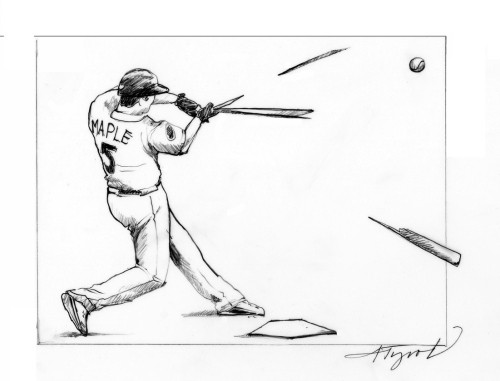
Those of us who enjoy forestry and baseball get a kick out of watching professional ballplayers stride to bat holding little pieces of the northern forest in their hands, though if you’re not a wood geek, you may not know that major league baseball has been embroiled in a bat controversy for the past two decades – a controversy that pits two of our beloved northern hardwood species against each other.
In one corner is white ash, the traditional wood of choice for making baseball bats. Ash works well because it grows fast, is sufficiently dense, and has straight grain. It became the industry standard and prompted poetry not just from baseball types, but tree types as well.
Here’s Donald Peattie in A Natural History of North America Trees:
“Every American boy knows a great deal about white ash wood. He knows the color of its yellowish sapwood and the pale brown grain of the annual growth layers in it. He knows the weight of white ash not in terms of pounds per cubic foot, but by the more immediate and unforgettable sensation of having lifted and swung a piece of it, of standard size. He even knows its precise resonance and pitch, the ringing tock of it when struck.”
In the other corner is hard maple, a species that came to prominence when Barry Bonds hit 73 home runs with a maple bat in 2001. Today, 20 bat makers sell maple bats to the big leagues (one uses the slogan: “Our maple kicks ash”), and about 50 percent of players use them.
Unfortunately, it’s not just the maple bat’s popularity that is exploding; the bats themselves are, too. Maple splinters in a way that’s much more dangerous than ash; you may have seen this on your woodlot, where the hinge on a hard maple tree will often break cleanly while ash, being more fibrous, will tear. In 2008, 2,800 bats broke in major league baseball games between July and September, and some players, coaches, and fans suffered horrible injuries from flying maple bat shards.
Faced with a major PR problem (sportswriter Jeff Passan began a piece in 2008 with the line: “Someone’s going to die at a baseball stadium soon.”), major league baseball enlisted the help of scientists from Harvard, the University of Massachusetts, and the US Forest Service’s Forest Products Laboratory in Madison, Wisconsin, to try to figure out why maple bats were breaking so explosively.
The scientists subsequently analyzed 2,232 broken bats and confirmed that the majority of broken bats had wood fiber angles that were off true – sometimes by as much as 14 degrees. At 10 degrees off true, wood loses up to 60 percent of its strength. Why the bad angles? Because of tree physiology, and because of the way the wood blanks are cut from the tree.
Ash is what wood technologists call a ring porous species – a nod to the fact that it develops very distinctive annual growth rings that feature clearly defined earlywood cells and latewood cells. Maple, on the other hand, is a diffuse porous species, with smaller pores that are more evenly distributed. As a result, ash bats tend to flake along the growth rings, while maple bats shatter.
To make matters more tricky, modern manufacturing methods saw each bat billet – in the old days billets were split. So instead of the wood cleaving naturally, it’s being sawn in a way that produces nearly invisible twisted fiber angles on the face-grain.
In light of these findings, stricter regulations went into effect requiring all bats to have a fiber angle of 3 degrees or less. Today, if you look closely at your favorite big leaguer’s maple bats, you’ll see an ink spot on the handle. The idea here is that the ink bleed makes the wood fiber angles easier to pick up, and equipment managers can use a slope-of-grain gauge to measure how true the bat is.
And, in a discovery that will surprise those who grew up learning that you should always hit on the edge grain of a bat (often analogized as “hitting on the edge of a deck of cards”), some researchers now say that wood can absorb impact better on its face grain. Players are still told to hit on the edge grain with ash bats, because the big porous growth rings can separate when the face grain contacts the ball. But with maple bats, players are advised by major league baseball to hit on the face side.
As a result of the regulations, bat breakage has decreased in the past few seasons, but a maple bat is still more likely to break than an ash bat and much more likely to shatter. In the minor leagues, low-density maple bats have been banned, but in the majors, ballplayers are still free to use them. As the emerald ash borer continues its ash-destroying march eastward, the question of maple versus ash will only get more complicated.

